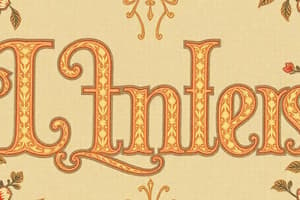Podcast
Questions and Answers
What is the main purpose of the alphabet?
What is the main purpose of the alphabet?
- To represent numbers
- To explore mathematical concepts
- To study the sounds of nature
- To provide a standardized tool for communication (correct)
Which of the following is NOT one of the main alphabetic systems used globally?
Which of the following is NOT one of the main alphabetic systems used globally?
- The Greek alphabet
- The Roman alphabet
- The Arabic alphabet (correct)
- The Cyrillic alphabet
What are letters in written language known as?
What are letters in written language known as?
- Figures
- Numerical characters
- Symbols (correct)
- Punctuation marks
What does phonetics study?
What does phonetics study?
What is the International Phonetic Alphabet (IPA) used for?
What is the International Phonetic Alphabet (IPA) used for?
How do letters fit into the realm of phonetics?
How do letters fit into the realm of phonetics?
What sound does the letter 'B' represent in the English alphabet?
What sound does the letter 'B' represent in the English alphabet?
Which IPA symbol represents the sound of the letter 'L' in the word 'lake'?
Which IPA symbol represents the sound of the letter 'L' in the word 'lake'?
What sound does the combination of 'sh' represent in phonetics?
What sound does the combination of 'sh' represent in phonetics?
In IPA, what sound does the letter 'Y' represent?
In IPA, what sound does the letter 'Y' represent?
Which IPA symbol represents the sound of the letter 'Q' followed by 'w' in the word 'quiet'?
Which IPA symbol represents the sound of the letter 'Q' followed by 'w' in the word 'quiet'?
What is the IPA symbol for the sound of 'th' in the word 'these'?
What is the IPA symbol for the sound of 'th' in the word 'these'?
Study Notes
The Alphabet: Letters, Phonetics, and Letter Sounds
The alphabet is a set of symbols that represent the sounds of spoken languages, providing a standardized tool for communication, learning, and educating. In this article, we'll explore the basic building blocks of the alphabet—letters, their sounds, and how they fit into the realm of phonetics, the study of speech sounds.
Letters
Letters, or alphabetic characters, are the basic units of written language. Today, there are three main alphabetic systems used globally: the Roman alphabet (used in English and many other languages), the Cyrillic alphabet (used in Russian, Bulgarian, and other Slavic languages), and the Greek alphabet (used in Greek, and in various scientific and mathematical fields). Each letter has a corresponding sound, and multiple letters can combine to form words.
Phonetics
Phonetics is the branch of linguistics that studies the sounds of human speech, including their production, transmission, and perception. When we discuss the alphabet in terms of phonetics, we're looking at how each letter corresponds to a sound, and how these sounds combine to form words and sentences.
The International Phonetic Alphabet (IPA) is a standardized tool used by linguists to represent the sounds of human speech. The IPA assigns symbols to every sound of every human language, providing a universal system for transcribing, analyzing, and teaching spoken language. While the IPA is used primarily by linguists, it can also be useful for understanding the sounds of the English alphabet.
Letter Sounds
To understand the alphabet, we first need to grasp the sounds associated with each letter. Let's take a look at the basic sounds of the English alphabet using the IPA symbols:
- A /æ/ - as in "apple"
- B /b/ - as in "big"
- C /k/ - as in "cat"
- D /d/ - as in "dog"
- E /ɛ/ - as in "egg"
- F /f/ - as in "five"
- G /g/ - as in "gorilla"
- H /h/ - as in "hat"
- I /ɪ/ - as in "it"
- J /dʒ/ - as in "jump"
- K /k/ - same as C ( redundant in IPA)
- L /l/ - as in "lake"
- M /m/ - as in "moon"
- N /n/ - as in "nest"
- O /o/ - as in "octopus"
- P /p/ - as in "potato"
- Q /k/ followed by /w/ - as in "quiet"
- R /r/ - as in "red"
- S /s/ - as in "snake"
- T /t/ - as in "table"
- U /juː/ - as in "unit"
- V /v/ - as in "vanilla"
- W /w/ - as in "whale"
- X /ks/ - as in "xenophobic"
- Y /j/ - as in "yellow"
- Z /z/ - as in "zebra"
In addition to pure consonants and vowels, letters can represent a variety of sounds. For example, "sh" represents the sound /ʃ/ (as in "shy"), and "th" can represent two different sounds: /ð/ (as in "these") and /ðɛ/ (as in "they"). The English language is rich and diverse, making it essential to understand not only the sounds associated with each letter but also their combinations and variations.
Understanding the alphabet is a crucial first step towards reading, writing, and communicating in our globalized world. By exploring the interplay between letters, phonetics, and the sounds they represent, we can deepen our understanding of our language and the world around us.
Studying That Suits You
Use AI to generate personalized quizzes and flashcards to suit your learning preferences.
Description
Test your knowledge about the alphabet by exploring letters, their phonetic sounds, and how they are used in language and communication. This quiz covers topics such as the International Phonetic Alphabet (IPA), letter sounds in English, and the relationship between letters and phonetics.




